Lin Zhang
Devision of Biostatistics, School of Public Health, University of Minnesota
An Information-Theoretic Approach to Transferability in Task Transfer Learning
Dec 20, 2022



Abstract:Task transfer learning is a popular technique in image processing applications that uses pre-trained models to reduce the supervision cost of related tasks. An important question is to determine task transferability, i.e. given a common input domain, estimating to what extent representations learned from a source task can help in learning a target task. Typically, transferability is either measured experimentally or inferred through task relatedness, which is often defined without a clear operational meaning. In this paper, we present a novel metric, H-score, an easily-computable evaluation function that estimates the performance of transferred representations from one task to another in classification problems using statistical and information theoretic principles. Experiments on real image data show that our metric is not only consistent with the empirical transferability measurement, but also useful to practitioners in applications such as source model selection and task transfer curriculum learning.
RRSR:Reciprocal Reference-based Image Super-Resolution with Progressive Feature Alignment and Selection
Nov 08, 2022



Abstract:Reference-based image super-resolution (RefSR) is a promising SR branch and has shown great potential in overcoming the limitations of single image super-resolution. While previous state-of-the-art RefSR methods mainly focus on improving the efficacy and robustness of reference feature transfer, it is generally overlooked that a well reconstructed SR image should enable better SR reconstruction for its similar LR images when it is referred to as. Therefore, in this work, we propose a reciprocal learning framework that can appropriately leverage such a fact to reinforce the learning of a RefSR network. Besides, we deliberately design a progressive feature alignment and selection module for further improving the RefSR task. The newly proposed module aligns reference-input images at multi-scale feature spaces and performs reference-aware feature selection in a progressive manner, thus more precise reference features can be transferred into the input features and the network capability is enhanced. Our reciprocal learning paradigm is model-agnostic and it can be applied to arbitrary RefSR models. We empirically show that multiple recent state-of-the-art RefSR models can be consistently improved with our reciprocal learning paradigm. Furthermore, our proposed model together with the reciprocal learning strategy sets new state-of-the-art performances on multiple benchmarks.
Solving Math Word Problem via Cooperative Reasoning induced Language Models
Oct 28, 2022Abstract:Large-scale pre-trained language models (PLMs) bring new opportunities to challenge problems, especially those that need high-level intelligence, such as the math word problem (MWPs). However, directly applying existing PLMs to MWPs can fail as the generation process lacks sufficient supervision and thus lacks fast adaptivity as humans. We notice that human reasoning has a dual reasoning framework that consists of an immediate reaction system (system 1) and a delicate reasoning system (system 2), where the entire reasoning is determined by their interaction. This inspires us to develop a cooperative reasoning-induced PLM for solving MWPs, called Cooperative Reasoning (CoRe), resulting in a human-like reasoning architecture with system 1 as the generator and system 2 as the verifier. In our approach, the generator is responsible for generating reasoning paths, and the verifiers are used to supervise the evaluation in order to obtain reliable feedback for the generator. We evaluate our CoRe framework on several mathematical reasoning datasets and achieve decent improvement over state-of-the-art methods, up to 9.8% increase over best baselines.
Graded-Q Reinforcement Learning with Information-Enhanced State Encoder for Hierarchical Collaborative Multi-Vehicle Pursuit
Oct 24, 2022Abstract:The multi-vehicle pursuit (MVP), as a problem abstracted from various real-world scenarios, is becoming a hot research topic in Intelligent Transportation System (ITS). The combination of Artificial Intelligence (AI) and connected vehicles has greatly promoted the research development of MVP. However, existing works on MVP pay little attention to the importance of information exchange and cooperation among pursuing vehicles under the complex urban traffic environment. This paper proposed a graded-Q reinforcement learning with information-enhanced state encoder (GQRL-IESE) framework to address this hierarchical collaborative multi-vehicle pursuit (HCMVP) problem. In the GQRL-IESE, a cooperative graded Q scheme is proposed to facilitate the decision-making of pursuing vehicles to improve pursuing efficiency. Each pursuing vehicle further uses a deep Q network (DQN) to make decisions based on its encoded state. A coordinated Q optimizing network adjusts the individual decisions based on the current environment traffic information to obtain the global optimal action set. In addition, an information-enhanced state encoder is designed to extract critical information from multiple perspectives and uses the attention mechanism to assist each pursuing vehicle in effectively determining the target. Extensive experimental results based on SUMO indicate that the total timestep of the proposed GQRL-IESE is less than other methods on average by 47.64%, which demonstrates the excellent pursuing efficiency of the GQRL-IESE. Codes are outsourced in https://github.com/ANT-ITS/GQRL-IESE.
Zero-Shot Learners for Natural Language Understanding via a Unified Multiple Choice Perspective
Oct 18, 2022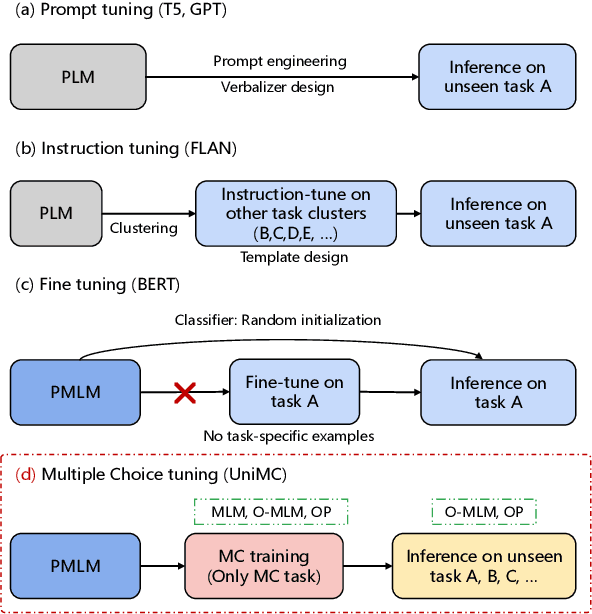

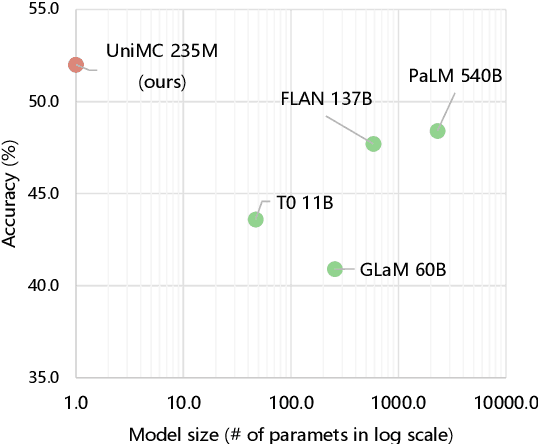

Abstract:We propose a new paradigm for zero-shot learners that is format agnostic, i.e., it is compatible with any format and applicable to a list of language tasks, such as text classification, commonsense reasoning, coreference resolution, and sentiment analysis. Zero-shot learning aims to train a model on a given task such that it can address new learning tasks without any additional training. Our approach converts zero-shot learning into multiple-choice tasks, avoiding problems in commonly used large-scale generative models such as FLAN. It not only adds generalization ability to models but also significantly reduces the number of parameters. Our method shares the merits of efficient training and deployment. Our approach shows state-of-the-art performance on several benchmarks and produces satisfactory results on tasks such as natural language inference and text classification. Our model achieves this success with only 235M parameters, which is substantially smaller than state-of-the-art models with billions of parameters. The code and pre-trained models are available at https://github.com/IDEA-CCNL/Fengshenbang-LM .
Improving Your Graph Neural Networks: A High-Frequency Booster
Oct 15, 2022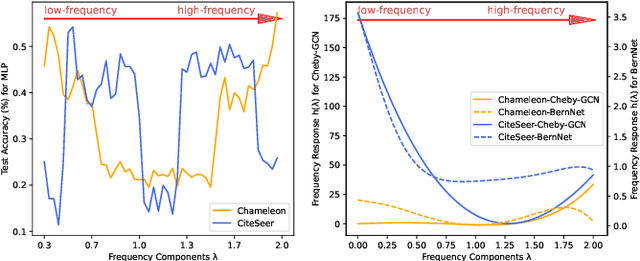
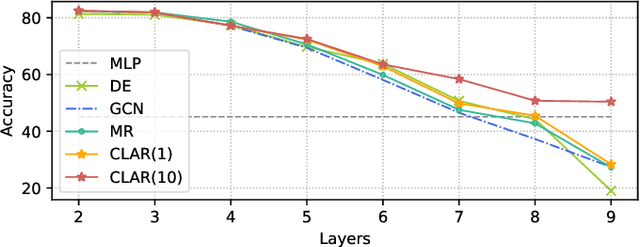


Abstract:Graph neural networks (GNNs) hold the promise of learning efficient representations of graph-structured data, and one of its most important applications is semi-supervised node classification. However, in this application, GNN frameworks tend to fail due to the following issues: over-smoothing and heterophily. The most popular GNNs are known to be focused on the message-passing framework, and recent research shows that these GNNs are often bounded by low-pass filters from a signal processing perspective. We thus incorporate high-frequency information into GNNs to alleviate this genetic problem. In this paper, we argue that the complement of the original graph incorporates a high-pass filter and propose Complement Laplacian Regularization (CLAR) for an efficient enhancement of high-frequency components. The experimental results demonstrate that CLAR helps GNNs tackle over-smoothing, improving the expressiveness of heterophilic graphs, which adds up to 3.6% improvement over popular baselines and ensures topological robustness.
MAP: Modality-Agnostic Uncertainty-Aware Vision-Language Pre-training Model
Oct 11, 2022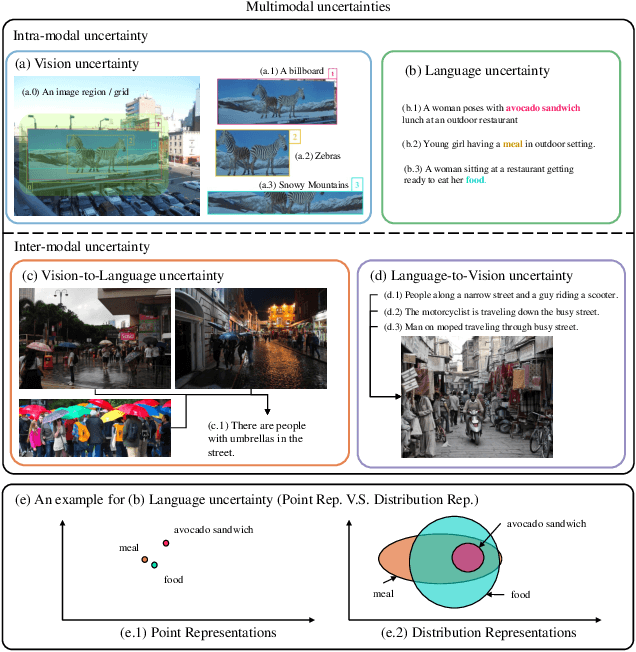
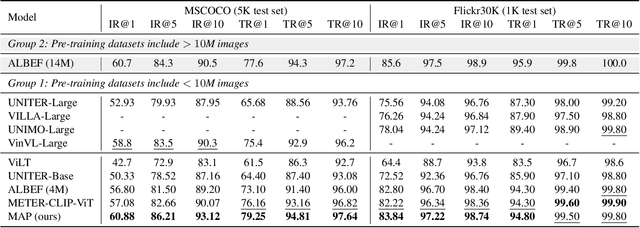
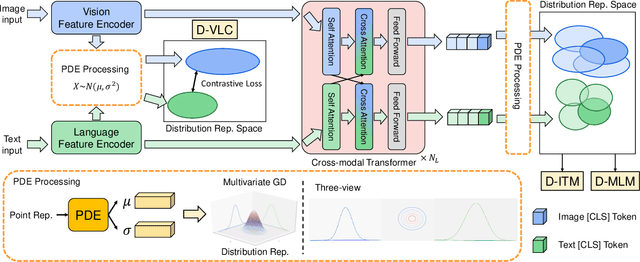
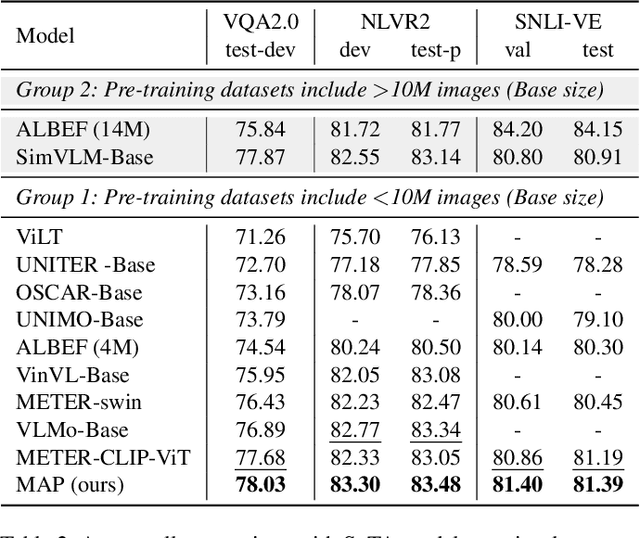
Abstract:Multimodal semantic understanding often has to deal with uncertainty, which means the obtained message tends to refer to multiple targets. Such uncertainty is problematic for our interpretation, including intra-modal and inter-modal uncertainty. Little effort studies the modeling of this uncertainty, particularly in pre-training on unlabeled datasets and fine-tuning in task-specific downstream tasks. To address this, we project the representations of all modalities as probabilistic distributions via a Probability Distribution Encoder (PDE) by utilizing rich multimodal semantic information. Furthermore, we integrate uncertainty modeling with popular pre-training frameworks and propose suitable pre-training tasks: Distribution-based Vision-Language Contrastive learning (D-VLC), Distribution-based Masked Language Modeling (D-MLM), and Distribution-based Image-Text Matching (D-ITM). The fine-tuned models are applied to challenging downstream tasks, including image-text retrieval, visual question answering, visual reasoning, and visual entailment, and achieve state-of-the-art results. Code is released at https://github.com/IIGROUP/MAP.
Deep Spectro-temporal Artifacts for Detecting Synthesized Speech
Oct 11, 2022
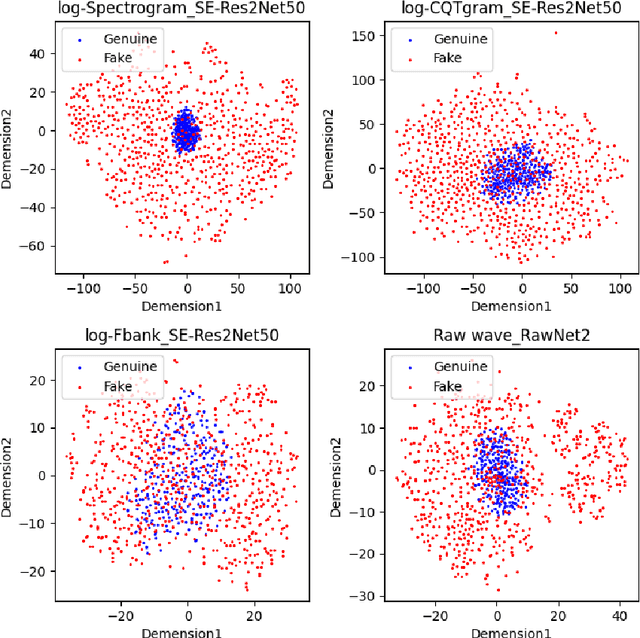

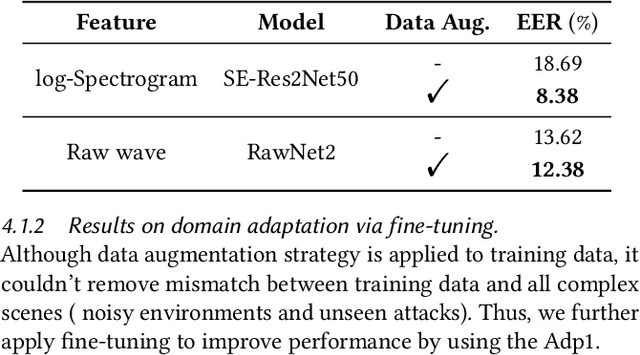
Abstract:The Audio Deep Synthesis Detection (ADD) Challenge has been held to detect generated human-like speech. With our submitted system, this paper provides an overall assessment of track 1 (Low-quality Fake Audio Detection) and track 2 (Partially Fake Audio Detection). In this paper, spectro-temporal artifacts were detected using raw temporal signals, spectral features, as well as deep embedding features. To address track 1, low-quality data augmentation, domain adaptation via finetuning, and various complementary feature information fusion were aggregated in our system. Furthermore, we analyzed the clustering characteristics of subsystems with different features by visualization method and explained the effectiveness of our proposed greedy fusion strategy. As for track 2, frame transition and smoothing were detected using self-supervised learning structure to capture the manipulation of PF attacks in the time domain. We ranked 4th and 5th in track 1 and track 2, respectively.
Learning "O" Helps for Learning More: Handling the Concealed Entity Problem for Class-incremental NER
Oct 10, 2022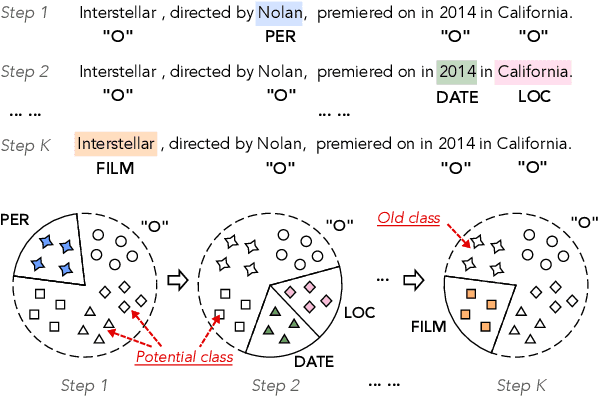
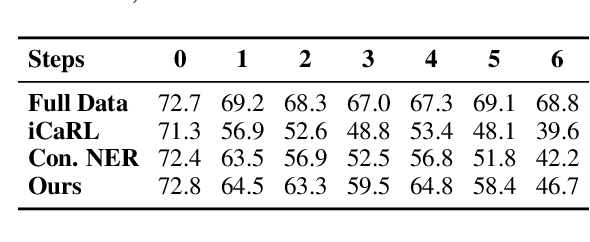
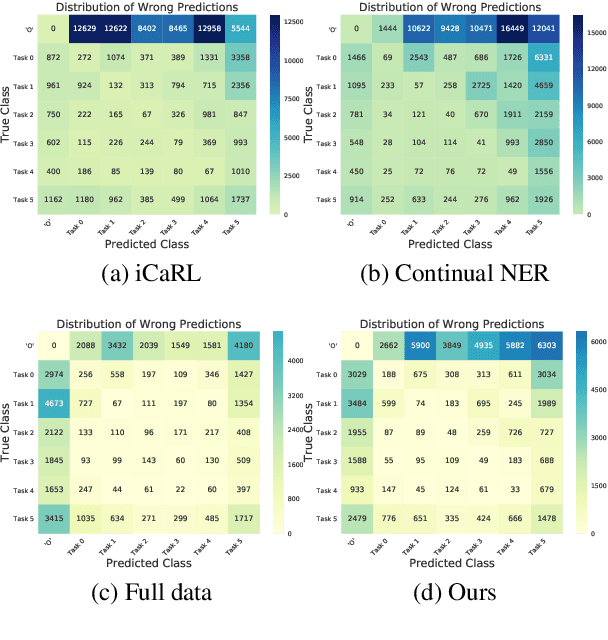

Abstract:As the categories of named entities rapidly increase in real-world applications, class-incremental learning for NER is in demand, which continually learns new entity classes while maintaining the old knowledge. Due to privacy concerns and storage constraints, the model is required to update without any annotations of the old entity classes. However, in each step on streaming data, the "O" class in each step might contain unlabeled entities from the old classes, or potential entities from the incoming classes. In this work, we first carry out an empirical study to investigate the concealed entity problem in class-incremental NER. We find that training with "O" leads to severe confusion of "O" and concealed entity classes, and harms the separability of potential classes. Based on this discovery, we design a rehearsal-based representation learning approach for appropriately learning the "O" class for both old and potential entity classes. Additionally, we provide a more realistic and challenging benchmark for class-incremental NER which introduces multiple categories in each step. Experimental results verify our findings and show the effectiveness of the proposed method on the new benchmark.
A Novel Framework based on Unknown Estimation via Principal Sub-space for Universal Domain Adaption
Sep 19, 2022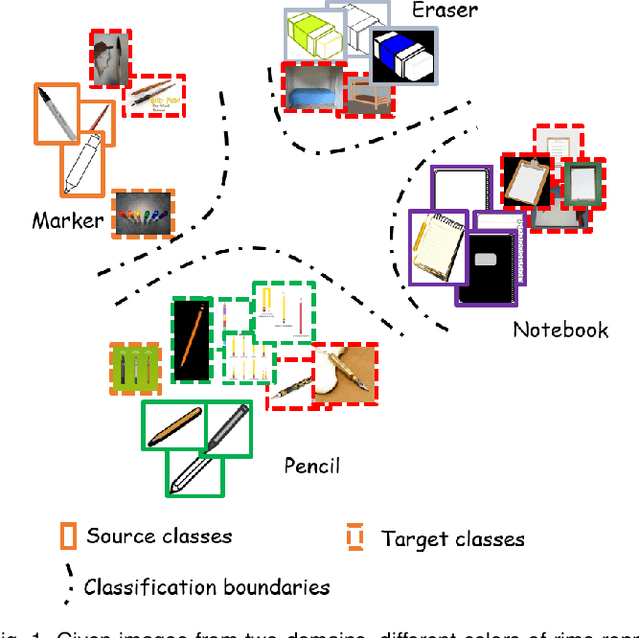
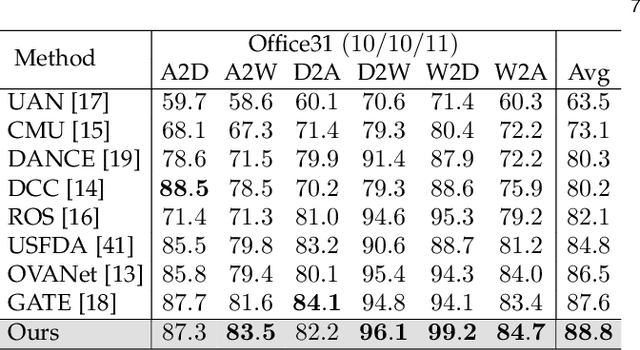
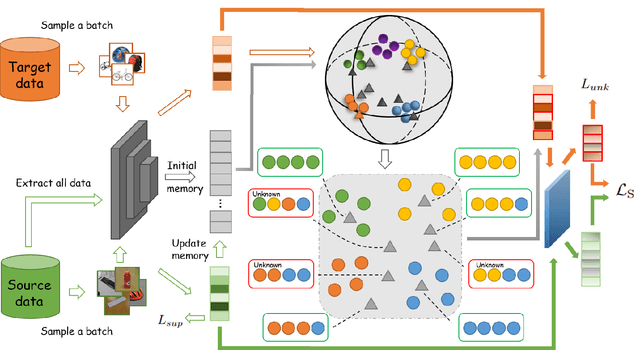
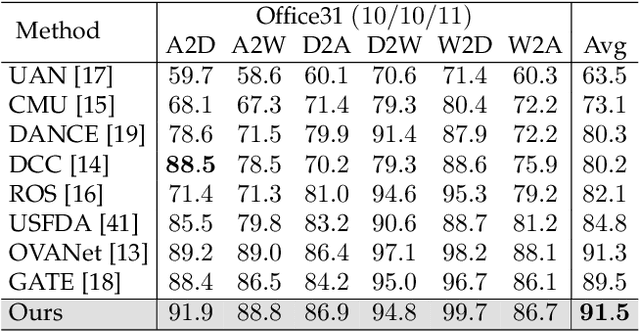
Abstract:Universal domain adaptation (UniDA) aims to transfer the knowledge of common classes from source domain to target domain without any prior knowledge on the label set, which requires to distinguish the unknown samples from the known ones in the target domain. Like the traditional unsupervised domain adaptation problem, the misalignment between two domains exists due to the biased and less-discriminative embedding. Recent methods proposed to complete the domain misalignment by clustering target samples with the nearest neighbors or the prototypes. However, it is dangerous to do so since we do not have any prior knowledge about the distributions of unknown samples which can magnify the misalignment especially when the unknown set is big. Meanwhile, other existing classifier-based methods could easily produce overconfident predictions of unknown samples because of the supervised objective in source domain leading the whole model to be biased towards the common classes in the target domain. Therefore, we propose a novel non-parameter unknown samples detection method based on mapping the samples in the original feature space into a reliable linear sub-space which makes data points more sparse to reduce the misalignment between unknown samples and source samples. Moreover, unlike the recent methods applying extra parameters to improve the classification of unknown samples, this paper well balances the confidence values of both known and unknown samples through an unknown-adaptive margin loss which can control the gradient updating of the classifier learning on supervised source samples depending on the confidence level of detected unknown samples at current step. Finally, experiments on four public datasets demonstrate that our method significantly outperforms existing state-of-the-art methods.
 Add to Chrome
Add to Chrome Add to Firefox
Add to Firefox Add to Edge
Add to Edge